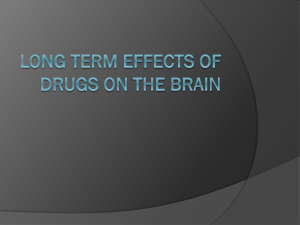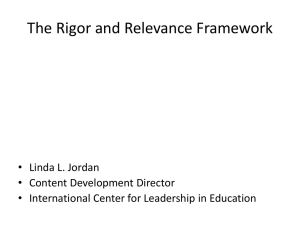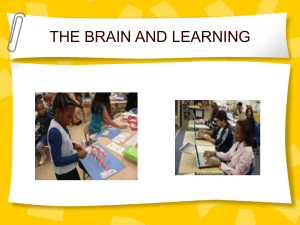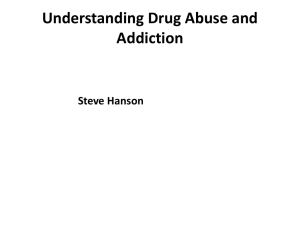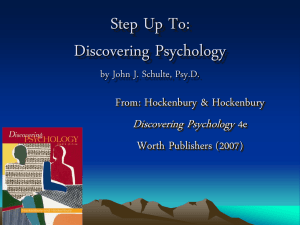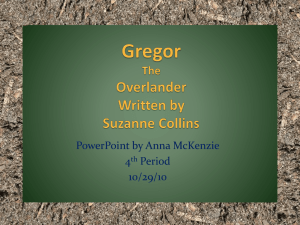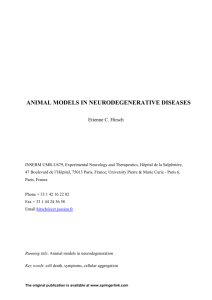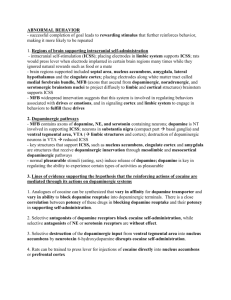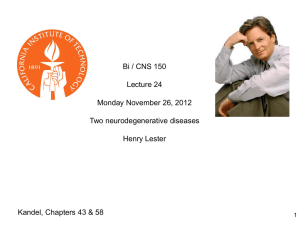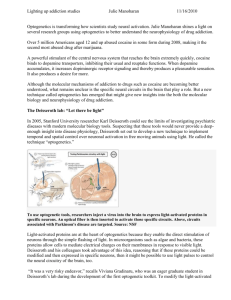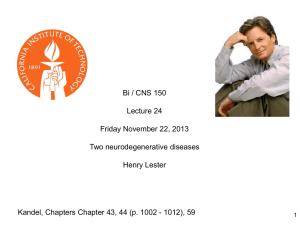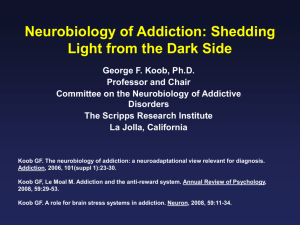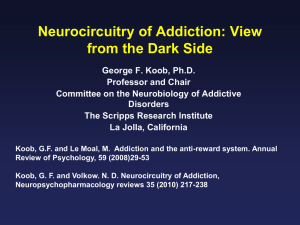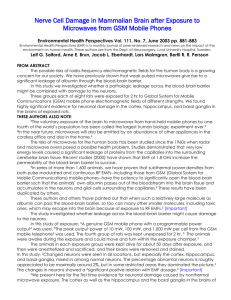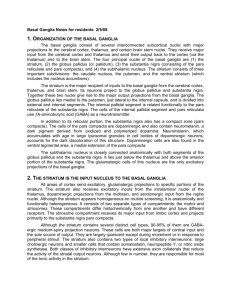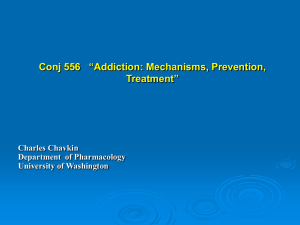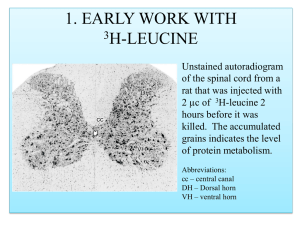Wanting Things - How Your Brain Works
advertisement
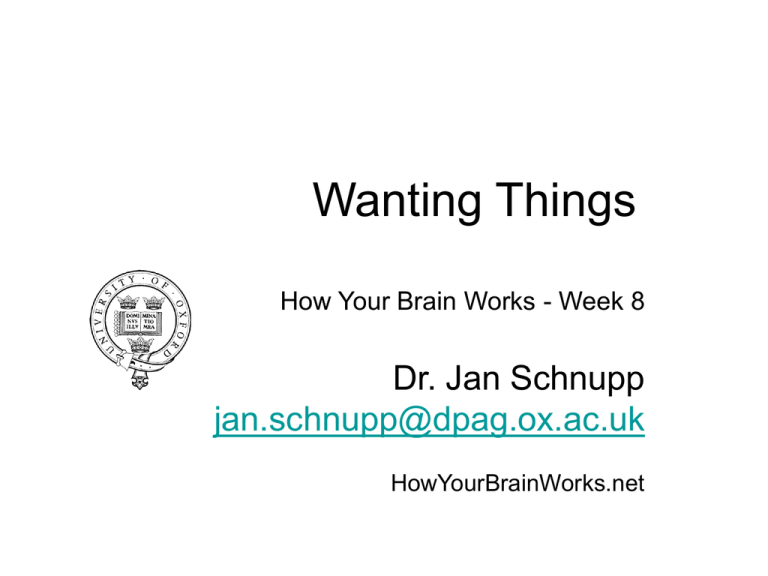
Wanting Things How Your Brain Works - Week 8 Dr. Jan Schnupp jan.schnupp@dpag.ox.ac.uk HowYourBrainWorks.net The Motor Loop • • • Excitatory (Glutamatergic) connections shown in dark green Inhibitory (GABAergic) connections shown in red Dopaminergic connections shown in sky blue Basal Ganglia Loops • Source: Redgrave et al 2010, Nature Neuroscience Basal Ganglia Loops • Source: Redgrave et al 2010, Nature Neuroscience Self stimulation experiments • First done by Olds & Milner in rats in 1954. They tested a wide range of stimulation sites but found that rats really only like self stimulation of the “septal” region. Reward circuitry Prefrontal Cortex Medial dorsal thalamus Nucleus accumbens Glutamate GABA Dopamine Ventral Tegmental Area • The Nucleus Accumbens is considered part of the ventral striatum Reward prediction • Recordings of dopaminergic neuron by Romo & Schultz (1990) in a monkey trained that, when a little door on a hatch opens, it can reach in to collect a food item. Dopamine Systems and John Chapin’s Robotic Rats Reward circuits in People • Winning • Loosing Elliot, Friston and Dolan, J Neurosci 2000 Pavlov’s Dog • • Ivan Pavlov, Nobel prize winner in 1904, first to describe “conditioned reflexes”. “Unconditioned” stimuli (e.g. food) automatically produce particular behaviours (salivating). “Conditioned” stimuli (e.g. sound of the dinner bell) produce responses only after a period of reinforcement learning. Dopamine and Synaptic Plasticity • Cortico-striatal glutamatergic synapses are highly plastic, and can undergo long term depression (LTD) or potentiation (LTP). • Dopaminergic input regulates this plasticity. • The molecular details are complicated (see Calabresi et al Trends in Neuroscience 2007) Reversal Learning and the PFC – basal ganglia network • Pasupathy & Miller, Nature 2005 Reversal Learning and the PFC – basal ganglia network • Pasupathy & Miller, Nature 2005 Temporal Difference (TD) Learning A clever dog might ask itself: • Which is the best predictor of an upcoming meal: the sound of the bell or the sound of the footsteps of an approaching carer? • Which of my actions makes the carer more likely to approach: barking or tail wagging? • What about tail wagging when the carer is looking vs tail wagging when he isn’t? Networks of Artificial Model Neurons Y=f(Σ xi·wi) • Multi-layer perceptrons and error back-propagation TD-Gammon • • Artificial neural network with 198 “input neurons”, (number of white or black pieces on various board positions and home positions, and whether white or black plays next), ca 40 “hidden” neurons and 4 “output” neurons. Trained to play backgammon at master level by adjusting connections between artificial neurons depending on changes in predicted outcome as games unfold (temporal difference learning). Rewarded and Unrewarded Trials • Recordings of dopaminergic neuron by Romo & Schultz (1990). A monkey was trained to slide his fingers along a wire placed out of sight to check whether or not a food item was placed at the end of it. Reward Neurons may respond more strongly to uncertain rewards • Fiorillo et al, Science 2003 Break Drug Self-administration experiments • Rats will self-inject of amphetamine into the Nucleus Accumbens. • D-amphetamine stimulates DA release by messing with transporter proteins in dopaminergic terminals of afferents from the VTA. Addictive drugs • Cocaine (crack cocaine in particular): potentiates DA action by blocking DA reuptake • Amphetamine (“speed”) and derivatives releases DA (and NA) by interfering with cell internal catecholamine transporters • Opiates: dopaminergric neurons in the brainstem and midbrain have opiate receptors. • Striatal neurons carry cholinergic receptors that are activated by nicotine. Addiction Potential • Why does smoking cocaine bring a greater addiction risk than drinking cocaine in tea? Developing Addiction • Rats can be trained to self-administer virtually all addictive drugs, including opiates, amphetamines, cocaine, alcohol and nicotine. • They usually need repeated exposure / prolonged access to intravenous drugs to develop an addiction. • Addictions are then marked by: – Escalation in dose – Habituation / Tolerance, and finally – Resistance to “extinction” when behaviours no longer deliver drugs, but deliver punishment (foot-shock) instead. Stress, Noradrenaline and the Locus Coeruleus The Amygdala • Koob & Le Moal 2008 “Addiction and the Brain Antireward System Dopamine Dysregulation Syndrome (DDS) • Parkinsonian patients receiving prolonged courses of dopamine-enhancing medication are at some risk of addictionlike side effects including: • Craving • Gambling • Hypersexuality • Hypomania • “Punding” (stereotypic behaviours) Stages in Addiction 1. Explorative drug taking is found to be pleasurable. 2. Positive reinforcement learning encourages repeated drug taking. 3. Habituation / Tolerance develops. 4. Withdrawal causes stress. Non-addict on a “High” • Koob & Le Moal 2008 Addict • Koob & Le Moal 2008 • Koob & Le Moal 2008 Individual Differences • Dalley et al (Science 2007) tested rats for “impulsiveness” • Impulsive rats have less effective D2/3 receptors in the ventral striatum. • They also escalate cocaine doses more quickly in self administration experiments.

